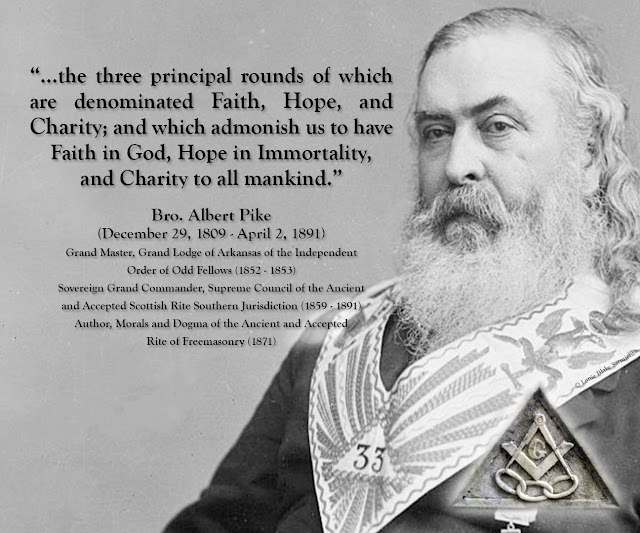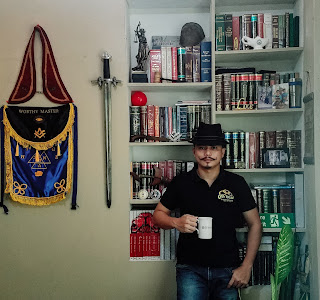ALBERT PIKE, AS AN ODD FELLOW AND FREEMASON
 |
| Brother Albert Pike was a Past Grand Master in Odd Fellowship and a Past Sovereign Grand Commander in Scottish Rite Freemasonry. |
 |
| Brother Albert Pike is one of the only Confederate military officers or figures honored with a statue in Washington, D.C. |
The origin of English fraternal orders can be more clearly traced from the demise of craft guilds. The historical connections are manifest in the rituals, terminology and functions shared by both the guilds and fraternal orders. In England, organizations and clubs with benefit systems took the form of the guilds or livery companies and reach back to the middle Ages.
 |
| The Master Baker and his Apprentice in the Guild of Bakers. |
As an Odd Fellow
 |
| The official emblem of the Ancient and Accepted Scottish Rite (A.A.S.R.) |
Scottish Rite Degrees
|
Year Revised
|
1-3°
|
1872
|
4-14°
|
1861, 1870, 1883
|
15-16°
|
1861, 1870, 1882
|
17-18°
|
1861, 1870
|
19-30°
|
1867, 1879, 1883
|
31-32°
|
1867, 1879, 1883
|
33°
|
1857, 1867, 1868, 1880
(manuscripts only)
|
 |
| The official Odd Fellows emblem of the Encampment first appeared in the rituals of the Loyal Ancient Order of Odd Fellows in 1805. |
NEW BOOK IN PROGRESS
TITLE: Sarmiento, Louie Blake S. The Encyclopedia of Philippine Fraternities and Sororities (Still in progress).
PUBLISHED BOOKS WRITTEN BY THE AUTHOR:
TITLE: Sarmiento, Louie Blake S. Odd Fellows: Rediscovering More Than 200 Years of History, Traditions, and Community Service (KDP Amazon, 2019).
TITLE: Sarmiento, Louie Blake S. Ancient Rites of Odd Fellowship: Revisiting the Revised Ritual of the Order of Patriotic Odd Fellows, 1797 (KDP Amazon, 2020).
About the Author
Louie Blake Saile Sarmiento finished his Associate in Health Science Education in 2007; Bachelor of Science in Psychology with Certificate in Human Resource Management and Certificate in Women’s Studies in 2010; Master of Arts in Industrial/Organizational Psychology in 2013; and Juris Doctor (law) degree in 2020.
He is instrumental in re-establishing Odd Fellowship in the Philippines. He is a Past Grand and Past District Deputy Sovereign Grand Master of the Independent Order of Odd Fellows. He is credited for connecting thousands of members from various countries when he created and managed the first social media groups and pages of the “Independent Order of Odd Fellows” and "Odd Fellows International" from 2009-2019. He is also credited for writing and creating most of the modern literature and infographics about Odd Fellowship on the internet at a time when the organization had almost zero presence online, including the first YouTube videos and the wikipedia entries about the Odd Fellows. Because of his contributions, he was appointed as Public Relations Coordinator and member of both the Communications Committee and the Revitalization Committee of the Sovereign Grand Lodge from 2012-2015. He spent more than six years visiting hundreds of Lodges and several Grand Lodges across the United States and Canada to read hundreds of journals, records and books; observe Grand Lodge sessions and meetings; and conduct interviews to be able to write books about the Odd Fellows.
He is an advocate for the preservation of historical fraternal organizations, service clubs and civic associations. He is a member of all branches of the Independent Order of Odd Fellows (IOOF), including the Rebekah Lodge, Encampment and Patriarchs Militant. He is also affiliated with the Grand United Order of Odd Fellows (GUOOF); Ancient Mystic Order of Samaritans (AMOS); Noble Order of Muscovites (Muscovites); International Order of DeMolay (IOD); International Order of Free Gardeners (IOFG); Universal Druid Order (UDO); Ordo Supremus Militaris Templi Hierosolymitani (OSMTH); Knights of Rizal (KOR); The Fraternal Order of Eagles - Philippine Eagles (TFOE-PE); and Tau Gamma Phi or Triskelion Grand Fraternity (TGP). As a hobby, he writes articles and collects books and artifacts related to fraternal organizations, service clubs and other civic associations.
Louie Blake Saile Sarmiento finished his Associate in Health Science Education in 2007; Bachelor of Science in Psychology with Certificate in Human Resource Management and Certificate in Women’s Studies in 2010; Master of Arts in Industrial/Organizational Psychology in 2013; and Juris Doctor (law) degree in 2020.
He is instrumental in re-establishing Odd Fellowship in the Philippines. He is a Past Grand and Past District Deputy Sovereign Grand Master of the Independent Order of Odd Fellows. He is credited for connecting thousands of members from various countries when he created and managed the first social media groups and pages of the “Independent Order of Odd Fellows” and "Odd Fellows International" from 2009-2019. He is also credited for writing and creating most of the modern literature and infographics about Odd Fellowship on the internet at a time when the organization had almost zero presence online, including the first YouTube videos and the wikipedia entries about the Odd Fellows. Because of his contributions, he was appointed as Public Relations Coordinator and member of both the Communications Committee and the Revitalization Committee of the Sovereign Grand Lodge from 2012-2015. He spent more than six years visiting hundreds of Lodges and several Grand Lodges across the United States and Canada to read hundreds of journals, records and books; observe Grand Lodge sessions and meetings; and conduct interviews to be able to write books about the Odd Fellows.
He is an advocate for the preservation of historical fraternal organizations, service clubs and civic associations. He is a member of all branches of the Independent Order of Odd Fellows (IOOF), including the Rebekah Lodge, Encampment and Patriarchs Militant. He is also affiliated with the Grand United Order of Odd Fellows (GUOOF); Ancient Mystic Order of Samaritans (AMOS); Noble Order of Muscovites (Muscovites); International Order of DeMolay (IOD); International Order of Free Gardeners (IOFG); Universal Druid Order (UDO); Ordo Supremus Militaris Templi Hierosolymitani (OSMTH); Knights of Rizal (KOR); The Fraternal Order of Eagles - Philippine Eagles (TFOE-PE); and Tau Gamma Phi or Triskelion Grand Fraternity (TGP). As a hobby, he writes articles and collects books and artifacts related to fraternal organizations, service clubs and other civic associations.
BOOKS ARE AVAILABLE ONLINE ON AMAZON, CLICK LINKS BELOW:
1. Odd Fellows Rediscovering More than 200 Years of History, Traditions and Community Service (Odd Fellows history and its relationship with world history)
Full color: https://www.amazon.com/dp/1733851208
Black and White: https://www.amazon.com/dp/1733851224
E-book: https://www.amazon.com/dp/B08Q8DKFJZ
2. Odd Fellows Manual: Modern Guide to the Origin, History, Rituals, Symbols and Organization of the Independent Order of Odd Fellows (brief history, organizational structure, and generally-accepted internal rules and principles)
Full color: https://www.amazon.com/dp/1733851259
Black and white: https://www.amazon.com/dp/1733851283
3. Ancient Rites of Odd Fellowship: Revisiting the Revised Rituals of the Order of Patriotic Odd Fellows, 1797
Black and white: https://www.amazon.com/dp/1733851232
E-book: https://www.amazon.com/dp/B08KHDG17S
4. Odd Fellows Encampment: A Brief History and Introduction to Patriarchal Odd Fellowship
Full color: https://www.amazon.com/dp/1733851275
E-book: https://www.amazon.com/dp/B08LZQQDWM
#newbooks #books #book #bookrecommendations #bookreviews #bookcommunity #booklover #bookstagrammer #booklovers #oddfellow #oddfellows #IOOF #independentorderofoddfellows #freemasons #freemasonry #fraternities #fraternity #fratman #sorority #sororities #secretsocieties #authorsofig #authorscommunity #author #indieauthor #indieauthors #booksofinstagram #bookblogger #bookshop #louieblakesailesarmiento #booksarelife #writerscommunity #writerscorner #writersofig #instawriters #writers
1. Odd Fellows Rediscovering More than 200 Years of History, Traditions and Community Service (Odd Fellows history and its relationship with world history)
Full color: https://www.amazon.com/dp/1733851208
Black and White: https://www.amazon.com/dp/1733851224
E-book: https://www.amazon.com/dp/B08Q8DKFJZ
2. Odd Fellows Manual: Modern Guide to the Origin, History, Rituals, Symbols and Organization of the Independent Order of Odd Fellows (brief history, organizational structure, and generally-accepted internal rules and principles)
Full color: https://www.amazon.com/dp/1733851259
Black and white: https://www.amazon.com/dp/1733851283
3. Ancient Rites of Odd Fellowship: Revisiting the Revised Rituals of the Order of Patriotic Odd Fellows, 1797
Black and white: https://www.amazon.com/dp/1733851232
E-book: https://www.amazon.com/dp/B08KHDG17S
4. Odd Fellows Encampment: A Brief History and Introduction to Patriarchal Odd Fellowship
Full color: https://www.amazon.com/dp/1733851275
E-book: https://www.amazon.com/dp/B08LZQQDWM
#newbooks #books #book #bookrecommendations #bookreviews #bookcommunity #booklover #bookstagrammer #booklovers #oddfellow #oddfellows #IOOF #independentorderofoddfellows #freemasons #freemasonry #fraternities #fraternity #fratman #sorority #sororities #secretsocieties #authorsofig #authorscommunity #author #indieauthor #indieauthors #booksofinstagram #bookblogger #bookshop #louieblakesailesarmiento #booksarelife #writerscommunity #writerscorner #writersofig #instawriters #writers










This comment has been removed by a blog administrator.
ReplyDelete